Tom Bihn Guide Pack Review
Heritage is important, be it in a country, a family, or even product design. Knowing where something came from tells you a lot about where it will go in the future, and most of the human enterprise is about trying to figure out what will happen next. If you know a bit about knives you will quickly understand how we got from Bob Loveless's elegant drop point hunter with a wonderful tapered tang to the Dozier drop point hunter with his remarkable heat treat on D2 steel to the modern marvels we have now equipped with ultra high performance steel. In a piece of gear like the Freeman Outdoor Gear 451 knife, there is the heritage of Loveless and Dozier.
The past informs the future.
Sometimes it is worthwhile to go back to the classic forms, to the design heritage from the past, and update it. The new Mini Cooper, for example, has sold quite well and captured some of the essence of the original. The new Tom Bihn Guide Pack is a bit like the new Mini--a nod to the past with updates that ready you for the future.
There are things about this future past pack that I really like and one thing that I wish was left in the past. It is a mixed bag, both literally (the side organizing pouches are amazing and cutting edge, while the main bag is decidedly older in its design) and from the point of view of evaluation. There are hikers and adventurers out that that the Guide Bag will appeal to in a nostalgic sense, but for the rest of us, it is an imminently capable bag with a ton of great ideas, but just a smidge below the best available (a lot of which comes from Bihn). I can see how it appeals to people that like that heritage look, but for me, the main compartment is just too old fashioned to make this pack an all-time great. Despite that one drawback, there are some things about the Guide Pack, both old and new, that makes it worth a look and one thing it does that serves as a portent for bag designs going forward industry-wide.
Here is the Guide Pack product page. The base configuration without the two side pouches the lashing strap and the ice pick strap sells for $240. As configured for review it would be $335 as I was sent the decked out version. No way around it--this is expensive. The Guide Pack is a modern update to the classic klettersack packs. The klettersack is a Bavarian design, which translates from the German into "climbing sack" or "climbing pack." It is a classic design with a significant past history and a good track record for performance. Klettersacks were and still are a common sight in the mountainous regions of Europe. TOPO Designs makes quite a few klettersack-style packs as well so that is probably the main competition for the Guide Pack. Unfortunately, I have no experience at all with TOPO stuff. Here is a written review of the Guide Pack. Here is the EDCF thread for that review. There are no video reviews of the Guide Pack. Here is my review sample (provided by Tom Bihn and already returned):

The first person to correctly guess the knife on the pack wins a free Kershaw Leek. Comment below.
Twitter Review Summary: Something old, something new, nothing blue.
Design: 1
This is also a big bag. You can stuff a lot of things into the main compartment. The side organizers hold a lot. Here is the "gear" organizer (no bonus points for IDing those two pieces of gear, they are bit conspicuous):
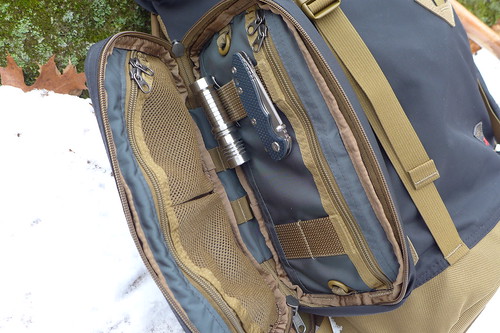
There is also a water bottle organizer, and on the review sample it was on the right side of the pack.
The top pouch that rests over the main compartment holds a lot too:
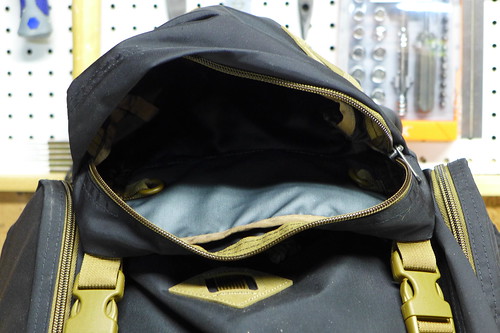
and there is specialized storage underneath that top pouch for cellphones and the like:
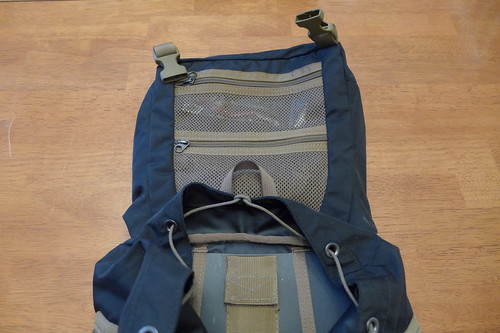
Here is a shot of the bag next to a Maxped Pygmy Falcon II:

It is even bigger than this picture would lead you to believe. This is a big 1900 cubic inch bag.
Fit and finish: 2
Carry: 2
The shoulder straps are typical Bihn, meaning great. There is a sternum strap as well and the whole pack, even when fully loaded (I put in about 11 pounds of clothes and a 25 pound weight for one hike) it works well and remains comfortable. I was worried that the interframe would dig in over time, but it doesn't. The straps and their positioning all made the Guide Pack quite nice.
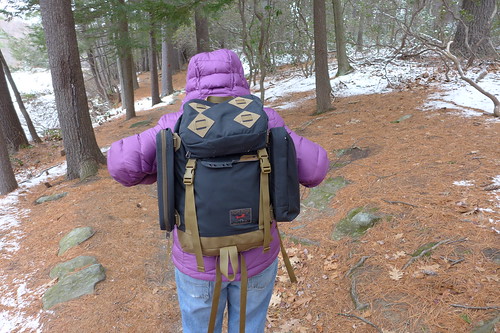
Here the model, my kind and patient wife, wore this medium to large sized pack nicely. Neither of us had problems with the pack in terms of carry. She is 5' 1.5" (again, only short people count half inches after they graduate 4th grade). I am 5' 10". Despite the height difference adjustments were simple and fast and the result was a good and subdued pack.
Materials: 2
The bag is made of 420d nylon, which was the original fabric used in parachute packs in the military. It was chosen for its strength and smooth feel. Long ago, it was also used in outdoor gear, but as times put pressure on the bottom line it was phased out in favor of newer and cheaper fabrics like Codura. The Guide Pack's product page has a lot of information about the fabric and why they chose it here. Personally, I like it a lot. I am not sure it is worth the increased expense (this is a $240 bag, at base, remember), but it is certainly nice and nice for all of the reasons Bihn mentions.
Accessibility: 1
But to focus on something that is so obvious and purposely designed as a throwback is unfair to this pack. The side compartments are brilliant. They are the wave of the future. This system works very well. I'd love to see a straight up tactical/day pack bag from Bihn designed to rival the PF II with these compartments. Heck, I'd probably buy a smaller version of these compartments as a standalone gear organizer. They are GREAT.
If you like the ruck sack/klettersack style pack, buy this pack. If you yearn for yesteryear outside, buy this pack. If you want something modern, get the Synapse or Synapse 25. But every pack rat out there should at least see how good the gear organizer side compartments are here. They are wonder.
A parting shot of the pack in my workshop. My Systainers said: "Hey, howya doin'" to the side compartments. They blushed a little. And I am huge weirdo for just writing those two sentences.

The past informs the future.
Sometimes it is worthwhile to go back to the classic forms, to the design heritage from the past, and update it. The new Mini Cooper, for example, has sold quite well and captured some of the essence of the original. The new Tom Bihn Guide Pack is a bit like the new Mini--a nod to the past with updates that ready you for the future.
There are things about this future past pack that I really like and one thing that I wish was left in the past. It is a mixed bag, both literally (the side organizing pouches are amazing and cutting edge, while the main bag is decidedly older in its design) and from the point of view of evaluation. There are hikers and adventurers out that that the Guide Bag will appeal to in a nostalgic sense, but for the rest of us, it is an imminently capable bag with a ton of great ideas, but just a smidge below the best available (a lot of which comes from Bihn). I can see how it appeals to people that like that heritage look, but for me, the main compartment is just too old fashioned to make this pack an all-time great. Despite that one drawback, there are some things about the Guide Pack, both old and new, that makes it worth a look and one thing it does that serves as a portent for bag designs going forward industry-wide.
Here is the Guide Pack product page. The base configuration without the two side pouches the lashing strap and the ice pick strap sells for $240. As configured for review it would be $335 as I was sent the decked out version. No way around it--this is expensive. The Guide Pack is a modern update to the classic klettersack packs. The klettersack is a Bavarian design, which translates from the German into "climbing sack" or "climbing pack." It is a classic design with a significant past history and a good track record for performance. Klettersacks were and still are a common sight in the mountainous regions of Europe. TOPO Designs makes quite a few klettersack-style packs as well so that is probably the main competition for the Guide Pack. Unfortunately, I have no experience at all with TOPO stuff. Here is a written review of the Guide Pack. Here is the EDCF thread for that review. There are no video reviews of the Guide Pack. Here is my review sample (provided by Tom Bihn and already returned):

The first person to correctly guess the knife on the pack wins a free Kershaw Leek. Comment below.
Twitter Review Summary: Something old, something new, nothing blue.
Design: 1
The main compartment is a vast cavern of storage with zero organization. Here is a shot of the main compartment indoors with good lighting:
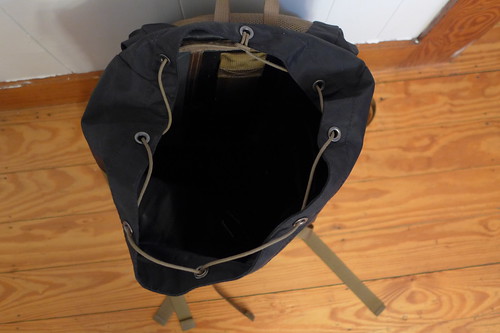
by comparison, here is the "down the hatch" shot for the Cadet with its lemon colored interior (same room, same lighting):
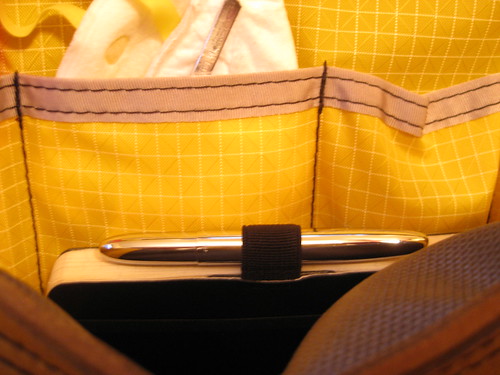
This thing is a black hole. That is one problem, but there are more. There is a frame to help it keep its shape, but in the end, that main compartment was a pain to use. Here is the "spine" of the bag, an aluminum and plastic frame sewn into the bag:
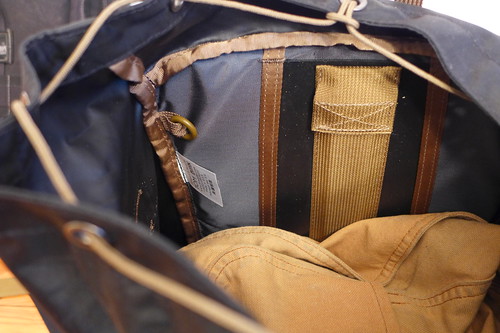
Despite the frame, there is no other way to really pack the main compartment other than stuffing things in there. If you want access to something in the main compartment you better pack correctly and hope it doesn't shift around, because if it falls from its perch there is no telling how long it will take you to find it, barring a full on bag dump. I used this pack on a number of day hikes and while doing other activities and every time I had to get something out of the main compartment it was an ordeal. I get that the main compartment is the thing that makes gray-haired hikers wax nostalgic, but compared to the stunning functionality of most Bihn bags, it is a disappointment.

by comparison, here is the "down the hatch" shot for the Cadet with its lemon colored interior (same room, same lighting):

This thing is a black hole. That is one problem, but there are more. There is a frame to help it keep its shape, but in the end, that main compartment was a pain to use. Here is the "spine" of the bag, an aluminum and plastic frame sewn into the bag:

Despite the frame, there is no other way to really pack the main compartment other than stuffing things in there. If you want access to something in the main compartment you better pack correctly and hope it doesn't shift around, because if it falls from its perch there is no telling how long it will take you to find it, barring a full on bag dump. I used this pack on a number of day hikes and while doing other activities and every time I had to get something out of the main compartment it was an ordeal. I get that the main compartment is the thing that makes gray-haired hikers wax nostalgic, but compared to the stunning functionality of most Bihn bags, it is a disappointment.
But because this is a Bihn bag, there are innovations that are a wonder to behold. The two side compartments with their extra degree of organization, forethought, and craftsmanship are amazing. Their modular nature is also great. Simply put, I love them. If they were smaller, and I am sure, given how Tom Bihn works, smaller versions will be released, I'd consider carrying one around with me and if you remember the Skinth review you know I hate sheathes (though the Skinth was a very good one). The side compartments take modularity to a whole new level. Bihn, Kifaru, GoRuck, Triple Aught Design, Maxpedition, and a few other bag companies have long sold "expansion" packs to supplement their main bags, but nothing touches the two side compartments on the Guide Pack, both in terms of design and integration with the main pack. They are secure and sublimely well-laid out.
Like I said, a true mixed bag, hence the 1.
This is also a big bag. You can stuff a lot of things into the main compartment. The side organizers hold a lot. Here is the "gear" organizer (no bonus points for IDing those two pieces of gear, they are bit conspicuous):

There is also a water bottle organizer, and on the review sample it was on the right side of the pack.
The top pouch that rests over the main compartment holds a lot too:

and there is specialized storage underneath that top pouch for cellphones and the like:

Here is a shot of the bag next to a Maxped Pygmy Falcon II:

It is even bigger than this picture would lead you to believe. This is a big 1900 cubic inch bag.
Fit and finish: 2
There is no other way to say this--the fit and finish on every Bihn product I own, have reviewed, and have used is simply superior. Nothing stray or ragged. Nothing too stiff or sandpapery, just useful, stately craftsmanship. The Guide Pack is no different. The entire pack is made of an older material that works quite well. Special attention is need for the side organizers for they are work of design art. The loops and pockets are perfectly sized and made.
Carry: 2
The shoulder straps are typical Bihn, meaning great. There is a sternum strap as well and the whole pack, even when fully loaded (I put in about 11 pounds of clothes and a 25 pound weight for one hike) it works well and remains comfortable. I was worried that the interframe would dig in over time, but it doesn't. The straps and their positioning all made the Guide Pack quite nice.

Here the model, my kind and patient wife, wore this medium to large sized pack nicely. Neither of us had problems with the pack in terms of carry. She is 5' 1.5" (again, only short people count half inches after they graduate 4th grade). I am 5' 10". Despite the height difference adjustments were simple and fast and the result was a good and subdued pack.
Materials: 2
The bag is made of 420d nylon, which was the original fabric used in parachute packs in the military. It was chosen for its strength and smooth feel. Long ago, it was also used in outdoor gear, but as times put pressure on the bottom line it was phased out in favor of newer and cheaper fabrics like Codura. The Guide Pack's product page has a lot of information about the fabric and why they chose it here. Personally, I like it a lot. I am not sure it is worth the increased expense (this is a $240 bag, at base, remember), but it is certainly nice and nice for all of the reasons Bihn mentions.
Accessibility: 1
The main compartment is a mess to retrieve anything out of and the rest of the bag is a dream. I took the bag with me when we went hiking, which we usually do on Saturday or Sunday. I also took it with me to my son's swim lessons. In both instances getting stuff out of the main compartment involved hobo-in-the-trash style rummaging or spilling things all over the place. If you have different sized objects, say like a towel and some goggles, good luck.
The remainder of the pack's compartments are simply amazing. I loved sliding gear into the side compartments, figuring out the optimal carry scratched an itch I think all gear geeks have. The compartment on the lid was excellent as well, easy to get it even when in motion. It was the perfect place to stash trail snacks. All of the compartments that weren't essentially drawstring sacks were awesome, truly awesome.
Over time I just resorted to using the other compartments and leaving the big pack for one or two large compressible items, like a towel or a jacket. That's the sort of work around that indicates a problem. If I am unable to use the main compartment of a bag because it is hard to access items in the bag, then I am pretty certain there is an issue.
Ease of Packing: 1
For reasons very similar to the problems in accessibility, this pack is a pleasure and a chore to pack all at the same time. In order to get the main pack to work I had to think of a layout that would both not shift during movement and at the same time offer a place for small objects to rest. If they some how fell off their perch or if I packed the bag incorrectly, it was all but goodbye. As you can probably guess from the review thus far, the non-main compartments were amazing.
Pockets/Organization: 2
The problems with the main compartment don't impact organization. Really, main compartments are just for big items, regardless of design, so organization and pockets are handled by supplementary compartments and here the Guide Pack excelled. One thing to note, there is no way you'd want to carry a laptop, camera gear, or a tablet in the main compartment without some additional pack or protection, another ding for the big sack design.
That said, not only were the side compartments and lid compartments excellent, there were retro style attachment points that not only worked well, but provided a welcome reprieve from the parade of mummy packs wrapped in MOLLE.
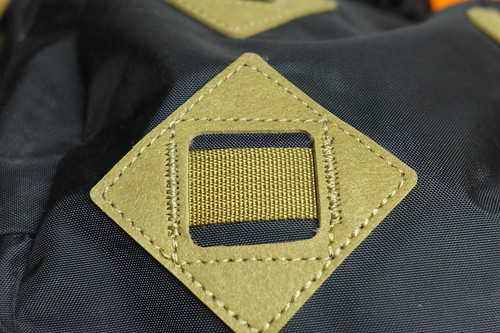
These diamond shaped attachment points were the jewels of organization their shape suggests. I LOVE THESE.
Snaps/buckles/zippers: 2
There are a few zippers on the pack and they differ from the "sealing" zippers found on the Cadet, but they are still excellent. The real innovation of the Guide Pack is the use of these buckles, called Annex clips, to attach the side compartments to the main pack:

The two outer plastic prongs lock together with the inner prong, once the inner prong is woven behind the straps seen here:

and the result is a fit that made me think the side compartments were actually sewn to the pack at first. There is no swinging or swaying of the large side compartments because of this system and it is a really clean look as well. The entire bag's snaps, zippers, and buckles work incredibly well to make a snug, clean looking, and well made system of expansion (more on this below).
The shoulder straps are typical Bihn, meaning great. There is a sternum strap as well and the whole pack, even when fully loaded (I put in about 11 pounds of clothes and a 20 pound weight for one hike) it works well and remains comfortable. I was worried that the interframe would dig in over time, but it doesn't. The straps and their positioning all made the Guide Pack quite nice.
Straps and belts: 2
The snaps and buckles are good. The main straps, the shoulder straps are excellent. And all of the supplemental straps are nice. I liked the ice axe strap, the bottom loop of which I used it for tethering a wide variety of things from my son's tiny hiking stick to clothing that he was wearing and got very dirty and wet. I didn't use it for an ice axe, but I did put a hatchet in there and it worked like a dream.
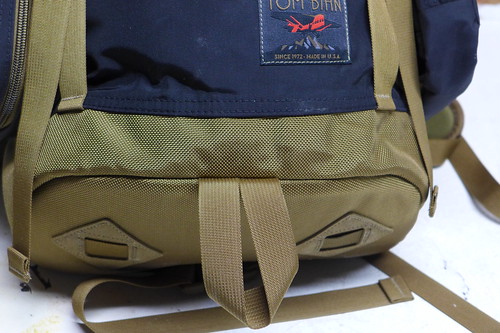
I also like the strap on the inside of the pack that lets it hang open. That would be particularly helpful if you were taking a shower outside or doing work that required the contents of the bag to be accessible and off the ground. Good all around.
Modularity/expansion: 2
I am sure you have noticed by now, but I think the side compartments, there design and layout, as well as their method of attachment are truly giant innovations. The use of MOLLE is nice. I have a tweaked and decked out Maxped bag covered in MOLLE and it is good. But this is better.

These expansion packs, of which there are a few different kinds (I was sent a gear organizer and a water bottle carrier), are the pack equivalent of the Festool Systainer system. For those of you not obsessed with woodworking or German tools, systainers are a system of modular, interlocking tool containers (they are available for use without tools and for packing as you see fit here). There are different sizes and they all work together kind of like Legos. The benefit of the systainer system is that everything works together and builds of other pieces. Comparing a systainer to the standard blow molded tool carriers is silly. One is a tool on its own and the other is something you wish you could throw away.
These side compartments are that much better than the standard MOLLE expansion pouches. The interior organization is nice, but some of the better brands made equally well-thought out MOLLE expansions. The real thing here is just how well integrated they are into this bag, thanks in large part to the innovative straps and buckles used. There is no "swinging through the trees" feel you get when you load up a set of MOLLE straps with expansion pounches and that's even when you have a main compartment here that is really just a sack. On a pack with a more rigid or structured main compartment these things would be seamlessly integrated both in terms of carry and looks. Once you get the hang of it, it is also easy to get on and off the main pack.
This is the future. I have no doubt. If this is something that can be patented (and isn't already), Bihn's IP lawyers need to get on the stick. This stuff is AMAZING.
Oh and here is the Guide Pack "naked" looking almost identical to an old fashioned klettersack of the 1950s.
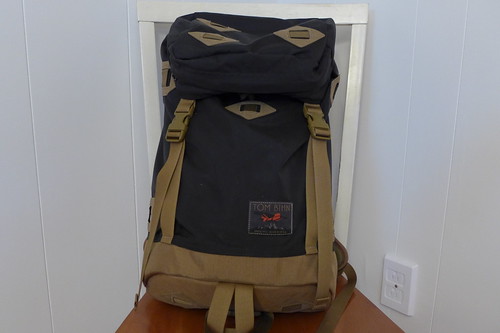
The side compartments integrate so well that you can even make the pack look good without them. This is the future.
Overall Score: 17 out of 20
The remainder of the pack's compartments are simply amazing. I loved sliding gear into the side compartments, figuring out the optimal carry scratched an itch I think all gear geeks have. The compartment on the lid was excellent as well, easy to get it even when in motion. It was the perfect place to stash trail snacks. All of the compartments that weren't essentially drawstring sacks were awesome, truly awesome.
Over time I just resorted to using the other compartments and leaving the big pack for one or two large compressible items, like a towel or a jacket. That's the sort of work around that indicates a problem. If I am unable to use the main compartment of a bag because it is hard to access items in the bag, then I am pretty certain there is an issue.
Ease of Packing: 1
For reasons very similar to the problems in accessibility, this pack is a pleasure and a chore to pack all at the same time. In order to get the main pack to work I had to think of a layout that would both not shift during movement and at the same time offer a place for small objects to rest. If they some how fell off their perch or if I packed the bag incorrectly, it was all but goodbye. As you can probably guess from the review thus far, the non-main compartments were amazing.
Pockets/Organization: 2
The problems with the main compartment don't impact organization. Really, main compartments are just for big items, regardless of design, so organization and pockets are handled by supplementary compartments and here the Guide Pack excelled. One thing to note, there is no way you'd want to carry a laptop, camera gear, or a tablet in the main compartment without some additional pack or protection, another ding for the big sack design.
That said, not only were the side compartments and lid compartments excellent, there were retro style attachment points that not only worked well, but provided a welcome reprieve from the parade of mummy packs wrapped in MOLLE.

These diamond shaped attachment points were the jewels of organization their shape suggests. I LOVE THESE.
Snaps/buckles/zippers: 2
There are a few zippers on the pack and they differ from the "sealing" zippers found on the Cadet, but they are still excellent. The real innovation of the Guide Pack is the use of these buckles, called Annex clips, to attach the side compartments to the main pack:

The two outer plastic prongs lock together with the inner prong, once the inner prong is woven behind the straps seen here:

and the result is a fit that made me think the side compartments were actually sewn to the pack at first. There is no swinging or swaying of the large side compartments because of this system and it is a really clean look as well. The entire bag's snaps, zippers, and buckles work incredibly well to make a snug, clean looking, and well made system of expansion (more on this below).
The shoulder straps are typical Bihn, meaning great. There is a sternum strap as well and the whole pack, even when fully loaded (I put in about 11 pounds of clothes and a 20 pound weight for one hike) it works well and remains comfortable. I was worried that the interframe would dig in over time, but it doesn't. The straps and their positioning all made the Guide Pack quite nice.
Straps and belts: 2
The snaps and buckles are good. The main straps, the shoulder straps are excellent. And all of the supplemental straps are nice. I liked the ice axe strap, the bottom loop of which I used it for tethering a wide variety of things from my son's tiny hiking stick to clothing that he was wearing and got very dirty and wet. I didn't use it for an ice axe, but I did put a hatchet in there and it worked like a dream.

I also like the strap on the inside of the pack that lets it hang open. That would be particularly helpful if you were taking a shower outside or doing work that required the contents of the bag to be accessible and off the ground. Good all around.
Modularity/expansion: 2
I am sure you have noticed by now, but I think the side compartments, there design and layout, as well as their method of attachment are truly giant innovations. The use of MOLLE is nice. I have a tweaked and decked out Maxped bag covered in MOLLE and it is good. But this is better.

These expansion packs, of which there are a few different kinds (I was sent a gear organizer and a water bottle carrier), are the pack equivalent of the Festool Systainer system. For those of you not obsessed with woodworking or German tools, systainers are a system of modular, interlocking tool containers (they are available for use without tools and for packing as you see fit here). There are different sizes and they all work together kind of like Legos. The benefit of the systainer system is that everything works together and builds of other pieces. Comparing a systainer to the standard blow molded tool carriers is silly. One is a tool on its own and the other is something you wish you could throw away.
These side compartments are that much better than the standard MOLLE expansion pouches. The interior organization is nice, but some of the better brands made equally well-thought out MOLLE expansions. The real thing here is just how well integrated they are into this bag, thanks in large part to the innovative straps and buckles used. There is no "swinging through the trees" feel you get when you load up a set of MOLLE straps with expansion pounches and that's even when you have a main compartment here that is really just a sack. On a pack with a more rigid or structured main compartment these things would be seamlessly integrated both in terms of carry and looks. Once you get the hang of it, it is also easy to get on and off the main pack.
This is the future. I have no doubt. If this is something that can be patented (and isn't already), Bihn's IP lawyers need to get on the stick. This stuff is AMAZING.
Oh and here is the Guide Pack "naked" looking almost identical to an old fashioned klettersack of the 1950s.

The side compartments integrate so well that you can even make the pack look good without them. This is the future.
Overall Score: 17 out of 20
It feels weird to have any major criticism of a Bihn bag, given how good they have been in the past. I guess this because Tom Bihn took his design cues from someone else, instead of relying on his own sterling ideas. His company makes bags that are great precisely because they defy tradition (see: Synapse's center carry water bottle holder), so to go back and embrace that tradition can be difficult. The Guide Pack is imminently capable, no question, but the main compartment stinks. I know a lot of old time hikers will love the nostalgia. It will fit right in with their VW Westfalia vans, but for the rest of us, it is a big, fat meh. The pack works, no doubt, but it could be better, as Bihn himself proves with the Synapse 25.
But to focus on something that is so obvious and purposely designed as a throwback is unfair to this pack. The side compartments are brilliant. They are the wave of the future. This system works very well. I'd love to see a straight up tactical/day pack bag from Bihn designed to rival the PF II with these compartments. Heck, I'd probably buy a smaller version of these compartments as a standalone gear organizer. They are GREAT.
If you like the ruck sack/klettersack style pack, buy this pack. If you yearn for yesteryear outside, buy this pack. If you want something modern, get the Synapse or Synapse 25. But every pack rat out there should at least see how good the gear organizer side compartments are here. They are wonder.
A parting shot of the pack in my workshop. My Systainers said: "Hey, howya doin'" to the side compartments. They blushed a little. And I am huge weirdo for just writing those two sentences.

